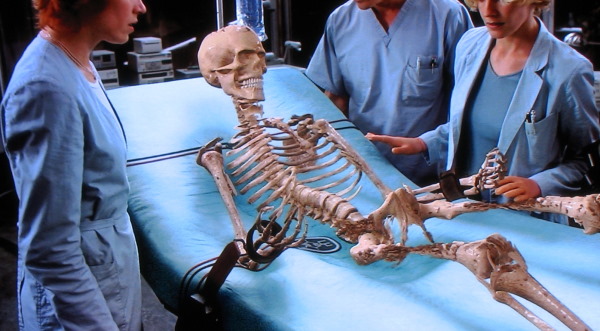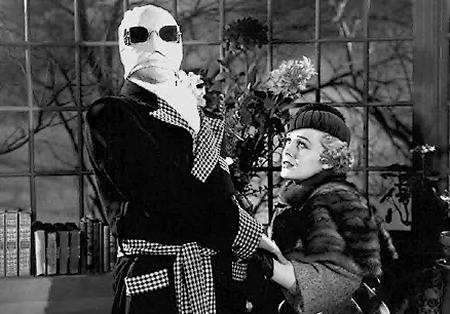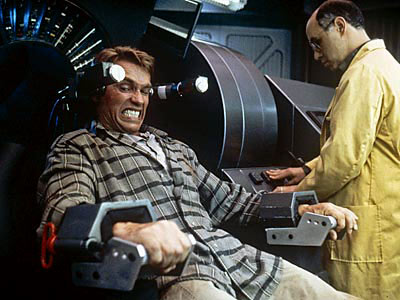From the August 11, 2000 Chicago Reader. — J.R.
Hollow Man
Rating *** A must see
Directed by Paul Verhoeven
Written by Andrew Marlowe
With Elisabeth Shue, Kevin Bacon, Josh Brolin, Kim Dickens, Greg Grunberg, Joey Slotnick, Mary Randle, and William Devane.
Apart from Space Cowboys, Clint Eastwood’s enjoyably auteurist swan song, Paul Verhoeven’s latest feature, Hollow Man, was the only summer Hollywood release I’d been looking forward to. For one thing, I’d hoped it would give me an opportunity to reassess his previous works, most of which I now think I underestimated when they were released.
I was pretty hospitable to Total Recall (1990), but I awarded a black dot to Basic Instinct (1992), mainly because I was incensed about the calculations of Joe Eszterhas’s $3 million script (I’m leaving aside Verhoeven’s Dutch movies because the only one I’ve seen is The 4th Man). I declined to review Showgirls (1995) at length, noting somewhat puritanically toward the end of my capsule: “I suppose the overall theory is that male spectators will tolerate any amount of stupidity and unpleasantness for the sake of acres of tits and ass, but you’ve got to hand it to the filmmakers for putting such a theory to the ultimate test: if anyone emerges from this with a smile on his face he must hate women as much as this movie does.” More equivocally, I accorded two stars to Starship Troopers (1997); I was fascinated with what wasn’t American about this allegedly all-American blockbuster, but I may have underrated some of the ways it was actively anti-American in its ridicule of American clichés, tastes, racial preferences, and archetypes.
In retrospect, I turned against Verhoeven mainly because of the way he combined misanthropy and potent eroticism — which I mistook for misogyny, a common error. I still think his misanthropy is problematic, and I don’t think his clear liking for and identification with his powerful women characters — a constant in his recent work, Showgirls included — necessarily excuses including a couple of rape fantasies in Hollow Man, even if both sequences are ambiguous and never get very far beyond voyeuristic preliminaries. (One turns out to be a dream of the heroine; the other is an aggressive encounter whose outcome we neither see nor hear about.) I would argue that Verhoeven is something of a dark moralist who’s fascinated by our worst impulses and that he’s also a very sexy director — which can create edgy and troubling overlaps. In Basic Instinct, Sharon Stone’s exuberant sexual exhibitionism and aggressiveness overlap with male fears about lesbian ice-pick killers; in Showgirls, we get both an exciting lap dance and mordant observations about capitalist sleaze, which are even harder to distinguish from each other. The easiest way to avoid analyzing all the resulting ambiguities is to hoot at everything, and I joined most of my colleagues in doing so.
Comparable ambiguities can be seen in Verhoeven’s considerable talent as a pop artist, fully apparent in his decorous billboard compositions and their clarity of line, which led director Jacques Rivette to compare him to Roy Lichtenstein (and to conclude that the giant spiders in Starship Troopers are superior to Spielberg’s dinosaurs). What often registers in Verhoeven’s work as mockery or irony, with all the trappings of satire, can also be read as just yarn spinning and gross-out mongering by a gifted comic-book artist, and much of the fascination of Starship Troopers rests on this sustained ambiguity.
Call it camp and you’re letting yourself off easy. Call it social criticism and you’re not doing justice to its ambivalent nature. Defending Showgirls as the best and most personal of Verhoeven’s American films, Rivette stressed that it’s every bit as disagreeable as the others: “It’s about surviving in a world populated by human garbage, that’s his philosophy.” Early in Hollow Man there’s a scene of foreboding in which a lab rat or mouse is deposited in its cage, and after it scampers across the floor it’s crushed into a bloody mess between the jaws of an invisible ape. At the press screening I attended, a couple of my younger colleagues, clearly won over by this preview of coming attractions — presumably envisioning many more broken rodent bones and gallons of rodent blood — giggled with glee, or at least with an adolescent-male braggadocio, echoing the legions of adolescent males who tend to populate Verhoeven’s pictures. Yet later in the movie, when an invisible human disposes of a dog in the lab in an equally brutal fashion, Verhoeven shows only a muddy solarized image on a video screen and immediately cuts away from it. This time there were no squeals or chortles from my colleagues. The promise of guts on the wall wasn’t being kept; it’s as if Verhoeven were turning the tables on some viewers’ expectations, as if he were saying to them, as politely as he knew how, “You actually want to see a dog’s guts get splattered? Fuck you, you Neanderthal ignoramuses. That’s really disgusting.” The comic-strip verve of his onslaught — goading us into behaving like assholes and then showing us what we’re doing — parallels the feisty and fatal charm of Sharon Stone manipulating Michael Douglas in Basic Instinct.
Next to the corrosive social commentary of Showgirls and Starship Troopers or even the satirical undertones of Total Recall and Basic Instinct, Hollow Man doesn’t look like much more than a straight-ahead SF action thriller, a genre exercise derived from an original script that’s delivered with exquisite punch and polish. (If you don’t want to know what some of the more predictable punches are, check out now.) It even has a mad scientist whose lab explodes at the end — as venerable a horror staple as one can imagine. And, as I’ve already noted, it has a prelude to sexual ravishment that turns out to be a dream — a cliché at least since Brian De Palma started using it repeatedly in the mid-70s. There’s a passing suggestion that the Pentagon might commit more mischief with invisibility than the selfish hero, but that’s about the sum of Verhoeven’s overt social commentary, apart from what he has to say implicitly about movie spectators.
Moreover, if you expect this movie to have anything to do with T.S. Eliot’s “The Hollow Men,” the only corroboration you’re likely to find is indirect. Yet this movie’s eroticism as well as its violence, combined with the hyperrealism of its overall look — including its brilliant special effects, which specialize in making bodies materialize from the inside out, with guts and veins sprouting and spreading like gardens — make it as much a Verhoeven production as any of its predecessors. It too makes ethical and ideological observations, in this case mainly about the implications of being invisible — in particular the significance of being able to watch someone without being watched back, a capacity available to anyone who watches a movie. And watching movies, as I suggested in my review of Total Recall ten years ago, is what Verhoeven’s movies are ultimately about.
I’ve just read H.G. Wells’s The Invisible Man (1897) for the first time and one of the disappointing things about it is that it doesn’t explore the erotic possibilities of being invisible in any way except for the limited eroticism of one man exerting power over other men — even though the title hero, like the title hero of Hollow Man, has to run around naked whenever he wants to be truly invisible. The same could be said of James Whale’s 1933 movie adaptation, though at least it boasts superb atmospherics and takes the Hollywood precaution of bringing in a romantic interest.
Griffin (Claude Rains), the invisible man, is given a former girlfriend — played by Gloria Stuart, who played Kate Winslet’s character as an old woman in Titanic –and she continues to dote on him, while he, by contrast, never shows the slightest interest in becoming a voyeur or unseen lover of her or any other woman. Yet paradoxically, though Rains’s character is every bit as selfish and mean-spirited regarding both people and animals as Wells’s and Verhoeven’s invisible men, he differs from both of them in that he becomes downright courtly whenever the leading lady is around. It’s not clear why, apart from the casting of Rains in the part, but there’s not a trace of leer in his comportment — in contrast to Verhoeven’s Sebastian Caine (Kevin Bacon), a creep from the very outset. Rains’s Griffin is full of mischief, but none of it’s sexual. (Furthermore, when he steals money from a bank and gaily distributes it to the general populace, this Depression-era prank doesn’t register as altruistic, but more like the idle whim of an anarchic Nietzschean superman, in keeping with Wells’s hero.)
Caine heads a team experimenting with invisibility on animals in a hidden compound for the Pentagon, and the team includes, among others, his former girlfriend Linda (Elisabeth Shue), her current boyfriend Matt (Josh Brolin), and a vet (Kim Dickens) who resents Sebastian’s cavalier and ruthless treatment of animals. (Could the vivisection theme represent some sort of surreptitious nod to Wells’s The Island of Dr. Moreau, published the year before The Invisible Man?) Lying to his Pentagon superiors, saying he hasn’t yet discovered the chemical formula that would make an invisible animal visible again, Caine also lies to most of his staff, saying he’s been given official permission to experiment on himself with the same formula. But once he makes himself invisible, he can’t return to normal, as the ape he experimented with did. He winds up a virtual prisoner of the compound while the team tries to find a way to bring him back– until he sneaks out one night and starts getting into mischief, most of it sexual.
Hollow Man — scripted by Andrew Marlowe from a story he wrote with Gary Scott Thompson — isn’t a formal adaptation of either Wells’s novel or Whale’s movie. But it carries so much of their baggage that it can’t be considered entirely independent of them. Like them, it features an amoral, bad-tempered title hero with huge scientific ambitions and delusions of grandeur — a loner who gradually goes mad as a result of his experiments and his inability to make himself visible again. (The last trait, but none of the others, was shared by Chevy Chase in the 1992 Memoirs of an Invisible Man.) Like Whale’s hero, Caine has a former girlfriend, but he’s a lot hornier, and he becomes a Peeping Tom who watches a next-door neighbor (Rhona Mitra) and goes into a jealous rage about the love life of his former squeeze.
Another pertinent difference seems more like a technical oversight: Griffin in Wells and Whale can be seen after he’s eaten something, at least until it’s fully digested, but Caine can eat or drink anything he likes without losing his invisibility — though no explanation for this anomaly (among others) is offered. Despite this movie’s propensity for technobabble and gadgets — such as the goggles and video screens that make Caine visible to members of his research team — its overall logic and plausibility are pretty loose. How, for instance, does Linda know that the invisible Caine, after escaping from the compound, has left his apartment as soon as she enters it?
The Whale movie offers no one apart from Griffin to engage most of our interest and attention; there’s an alleged rival for the leading lady’s affections who’s enslaved by Griffin, but he’s a coward who never threatens to become a hero of any kind. Hollow Man has Linda (or Lin, as she’s usually called) as the actual protagonist, with Caine serving alternately as villain and as putative surrogate for the spectator — i.e., us. And so we shift back and forth between alternate identification figures that sometimes even merge. When, for example, point-of-view shots of an invisible Caine removing Lin’s panties and bra while she’s asleep turn out to be Lin’s own troubled dream, the confluence of viewpoints is a lot more interesting than a simple replay of the familiar De Palma scare tactic.
“It’s amazing what you can do when you don’t have to look at yourself in the mirror anymore,” Caine remarks toward the end of this picture. This is what Verhoeven movies always pretend to promise us — it’s their perpetual cynical escape clause. Happily, they never begin to deliver, for looking into a mirror of one sort or another is precisely what his movies get one to do, regardless of how ugly and distorted, or how grotesque and accurate, the reflected image turns out to be. Total Recall gave us moviegoing as mindless tourism, Showgirls gave us America as a giant Las Vegas whorehouse, Starship Troopers gave us the whole planet as a fascist utopian America. And what does Hollow Man give us apart from a gripping genre exercise? Moviegoing as leering and chortling over crushed mice.












